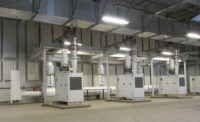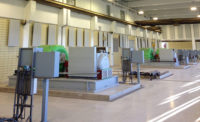Boost hearing protection, safety & productivity

Industrial plants are known for being loud, acoustically-harsh environments. The combination of high ceilings, reflective surfaces and the din from heavy machinery creates an optimal environment for reverberation and noise. Such conditions can decrease productivity and increase health and safety hazards, creating a unique challenge for facility managers. That is the problem the Coney Island Wastewater Treatment Plant faced after an evaluation of the acoustic levels in its facility.
OSHA ran tests throughout the plant and concluded that noise in the pump room and blower room exceeded safe levels. Average noise levels in the pump room registered 92 dBA, and in the blower room, 87 dBA. At these levels, communication among plant staff becomes difficult, if not impossible, and prolonged exposure can be damaging to workers’ hearing.
The materials from which the two large rooms are constructed contributed to the problem. The walls and floors are concrete, and the ceiling is a metal deck—all highly reflective surfaces. In addition, both rooms house several machines that generate excessive noise. But the construction and configuration of the rooms are integral to their functions and could not be changed. The plant’s operators knew they needed a solution that would work in the rooms “as is,” and they set about finding one.
Acoustical consulting engineers were tasked with finding a solution that would reduce the noise and reverberation in the pump and blower rooms to safe levels. After conducting acoustic analysis and evaluation, the engineers recommended the installation of sound-absorbing acoustic panels on specific wall and ceiling surfaces to achieve a reverberation goal of 85 dBA or less.
Acoustic panels absorb sound and reduce reverberation, decreasing the risk of harm from exposure to excessive noise and increasing the clarity and intelligibility of speech. The panels are ideal for industrial applications because of their versatile and durable design. They are suitable for new or existing facilities and can be installed around sprinkler heads, lighting fixtures, heating and ventilation ducts, and the like. They are durable, fire-resistant and require little or no maintenance. The panels comprise a perforated metal (aluminum and galvanized or stainless steel) frame that holds a fibrous insulation material.
Pump room solution
In the pump room, which is 87 ft. wide by 153 ft. long and 41 ft. high, there are four sets of 2,500 HP diesel engine generators that drive 600 HP motors, which operate the pumps. Prior to the installation of the acoustic panels, sound level measurements were taken at eight locations within the room at various distances from the engine generators.
With one set of engine generators and three pumps running, the average noise measured 92.5 dBA. The installed panels brought that down to 82.7 dBA, a reduction of 9.85 dBA. With two sets of engine generators and four pumps running, average noise levels registered even higher. Still, the panels worked, bringing the average below the 85 dBA safety threshold.
The solution involved covering about 50 percent of the ceiling (6,602 sq. ft.) and about 10 percent of the walls (2,069 sq. ft.) with the sound-absorbing panels. For the ceiling treatment, three-quarters of the panels are 30 in. by 10 ft.; the remainder, 30 in. by 8 ft. On the walls, a mix of panels measuring 48 in. by 8 ft. and 24 in. by 6 ft. was installed.
Blower room solution
The blower room measures 53 ft. by 120 ft. and 25 ft. high. Acoustic test results similar to those of the pump room were obtained. And here too, a mix of panel sizes was used—30 in. by 10 ft., 30 in. by 8 ft., 30 in. by 4 ft., and 42 in. by 5 ft.; a total of 2,651 sq. ft. of panels—to achieve the noise reduction goal. After installation, with two blowers running, the average noise level fell more than 5 dBA, from 86.6 to 81.3.
Conclusion
Based on the results, noise-reducing acoustic panels fit the bill for the Coney Island Wastewater Treatment Plant. They provided a practical and economical way to rein in the facility’s troublesome and hazardous acoustic conditions. The results exceeded OSHA requirements, increased worker hearing protection, and improved plant safety and communication. In general, acoustic panels offer a practical solution for reducing noise in a wide variety of industrial settings.
Looking for a reprint of this article?
From high-res PDFs to custom plaques, order your copy today!





